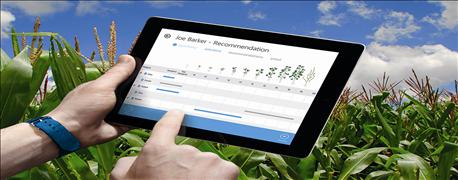April 1, 2016

Sponsored Content
Farming has become a game of numbers, where managing inputs and crop yields involves making the right choices every step of the way. The use of data in these decisions is becoming critical to every farm’s success. This information explosion is often called the Agriculture Information Technology revolution — AgIT for short.
MaglisTM is a new online agricultural platform designed to help farmers manage crops more effectively. The key is connecting technology, data and people in a seamless environment so farmers can make decisions that have the greatest impact on their bottom lines.
 The new Maglis Customer Navigator from BASF will enhance the connection and communication between farmer and the Innovation Specialist with new tools for communicating application plans and other information to the appropriate trusted partners.
The new Maglis Customer Navigator from BASF will enhance the connection and communication between farmer and the Innovation Specialist with new tools for communicating application plans and other information to the appropriate trusted partners.
Paul Rea, senior vice president, Crop Protection, North America, BASF, says: “Through Maglis, BASF will work with farmers to further personalize their experience, and enable them to develop a complete plan tailored for each growing season, and ultimately achieve their operational goals.”
BASF’s Grow SmartTM program lets farmers maximize yield and performance by working with Innovation Specialists. Maglis builds on that success with enhanced planning for a more personalized grower experience. And the system lets the grower optimize production decisions, inputs and practices to tailor a plan for each season.
The Maglis platform will launch in North America. The first product out of the chute
in the U.S. is the Maglis Customer Navigator, where BASF Innovation Specialists partner with farmers to analyze and tailor plans to address individual crop priorities, such as yield, risk reduction and efficiency. With the Maglis Customer Navigator, BASF can guide crop-related discussions with farmers, providing an enhanced platform for agronomic advice.
 Maglis is entering the U.S. market and key players explained its value. Clockwise from top left - Paul Rea, senior vice presidient, crop protection, BASF; Bruce Erickson, Purdue University; Ben Moore, Stateline Precision Ag; Neil Doherty, BASF innovation specialist.
Maglis is entering the U.S. market and key players explained its value. Clockwise from top left - Paul Rea, senior vice presidient, crop protection, BASF; Bruce Erickson, Purdue University; Ben Moore, Stateline Precision Ag; Neil Doherty, BASF innovation specialist.
With the tool, BASF Innovation Specialists can include proprietary products, such as adjuvants and retail-branded active ingredients, in the farmer’s crop recommendation. This application information can be sent directly to the retailer, custom applicator and others to ensure cropping plan tactics are carried out properly during the season.
What sets Maglis apart from other data platforms is its integral link between customer and Innovation Specialist. Farmers no longer have to wade into the on-farm data themselves; they can consult with the Innovation Specialist to build the right plan for the new crop year. The farmer controls the data, and communication is enhanced throughout the process. Read on to learn more about the role of AgIT in the future, and how Maglis will be meeting those needs.
The evolution of AgIT
Bruce Erickson, agronomy education outreach director, Purdue University, has been following precision agriculture for more than 20 years. “What we used to call ‘precision agriculture,’ we’re just going to be calling ‘agriculture’ in the future,” he observes. “We’re seeing a rapid adoption of new technology for the farm.”
Erickson notes, however, that in the past the adoption has been more GPS-dependent — such as autosteering and section-control technologies that offer a faster visible payback for the producer.
The future, which brings computer precision, sensor technology, cloud computing, cellphone networks and telematics to agriculture, offers the ability to enhance how information is stored, transferred and processed.
“We will see functional soil map information for making decisions,” Erickson says. “We’ll have spatially dense soil mapping with more useful information, and we’ll see greater use of high-resolution imagery. But the technology is exceeding our ability to interpret and understand what we’re seeing.”
Making sense of the information to create valid recommendations to help a farm profit is made easier with the Maglis Customer Navigator, and this system will add new features in the future, too. This approach will help farmers leverage their information to make better agronomic decisions.
Indiana farmer puts system to work
Ben Moore, president of Stateline Precision Farms near Fort Wayne, Ind., has been testing the Maglis Customer Navigation tool on his farm and likes what he sees. “I farm with my uncle and some area farmers,”
he says. “We created a new operation — Stateline Precision Farms. And we do straddle Indiana and Ohio. We raise corn in Indiana, but the bins are in Ohio.”
The 7,000-acre operation relies on quality information for decision-making. Moore has a board of
directors, and he works closely with Neil Doherty, a BASF Innovation Specialist. “Neil and I have a trusted relationship, and we work together on plans for the operation,” Moore says.
Adds Doherty: “We work together on different parts of the operation, from seed to crop protection, and there’s trust because of the knowledge I can bring to the table.”
Doherty says he consults with Moore to build plans and react in season when conditions change. In 2015, those conditions did change, and a tool like Customer Navigator would have been a tremendous resource. “We had a lot of rain, and fields were flooded out,” Doherty recalls. “I could not get to Ben’s place to scout with him, and he relayed information to me that I relayed to the retailer. That would have been easier with Maglis.”
The Customer Navigator can be set up as a complete in-season communication tool. In the example Doherty cited, the Maglis technology would have allowed Moore to share scouting information; Doherty to make recommendations; and with the push of a button, Moore, his retailer and even his custom applicator to acquire needed product application information.
“And you would know it’s accurate because everyone gets the same thing at the same time,” Doherty adds. “Would it have helped us during the flooding last year? Absolutely.”
More tools coming soon
The Maglis Customer Navigator is just the start. BASF is already working in Canada with two more powerful tools that will be launched in the United States in the future. Launch date for these two products has not yet been set. Here’s a look at both:
Maglis Sustainability Assessment. With more attention focused on the sustainability of agriculture, this is a tool many farmers will find valuable. Using the assessment, a farmer can see how specific practices will impact business profitability, soil health and biodiversity. Farmers can count on a comprehensive analysis of their operations from planning through harvest and will be able to compare their production practices to other benchmarks.
Maglis Crop Plan. This tool will allow a farmer to monitor and manage field activities. The system connects to information about local weather, soil conditions, and weed, disease and pest warnings for farmers’ individual plans.
More tools are under development for the Maglis platform. Learn more about Maglis at maglis.basf.com.
The new Maglis Customer Navigator from BASF will enhance the connection and communication between farmer and the Innovation Specialist with new tools for communicating application plans and other information to the appropriate trusted partners.
Maglis Sustainability Assessment, only available in Canada, will help farmers determine how their actions can impact the long-term sustainability of their operations.
Maglis Crop Plan, only available in Canada now, will enhance your ability to plan and execute actions in fields before and during the season. The tool also offers a range of other features for crop production. It will come to the U.S. in the near future.
You May Also Like




